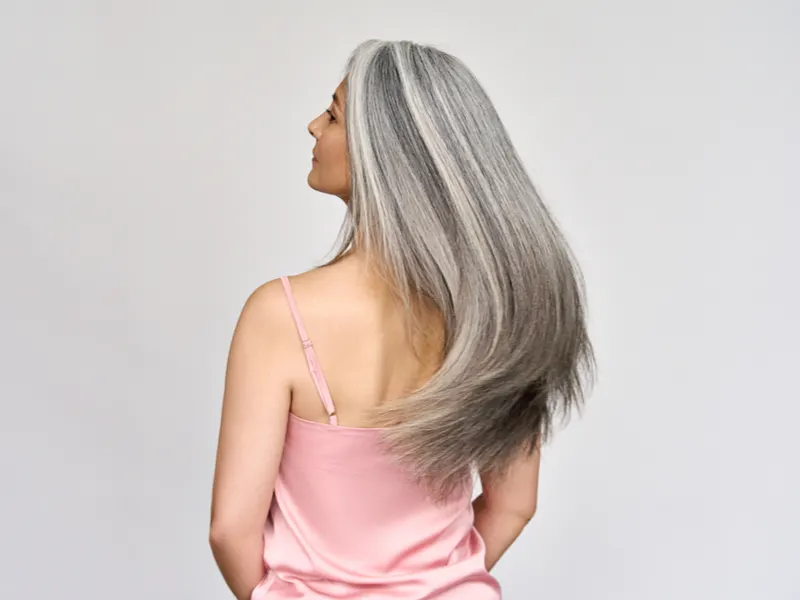Jump to:
Age happens to us all, and if you’ve been dying your hair to prevent grays, you might be ready to accept the gray underneath.
After all, it’s a beautiful color and a sign of strength and age. However, it can be a difficult process, especially if you don’t know how to grow out gray hair that is colored.
Growing Out Colored Gray Hair: A Summary

Jacob Lund/Shutterstock
To grow out gray hair that is colored, you can continue using the salon for low light treatments or color correction. Otherwise, you can get a short haircut and let it grow out naturally. These methods all work to grow out gray hair.
Here are the four methods for growing out gray hair:
- Put in Lowlights
- Use Color Correction
- Cut it Short
- Let it Grow Out
These are all acceptable methods, but they have pros and cons. We’ve gone in-depth into the four most common ways to grow out gray hair.
How to Grow Out Gray Hair That Is Colored: 4 Methods
If your hair is colored and you are ready to embrace the gray, welcome to the club! It’s a beautiful and natural thing and is being embraced by celebrities and people around the world. It’s a process, but your hairstylist can make it easier with lowlights.
Or you can jump right in with another way. There are several methods to grow out your gray hair. The one that works best for you is an individual choice, depending on the health of your hair, your budget, and how willing you are to make a drastic hair change.
However, any of these methods can take from six months to a year and will result in lovely, natural gray hair.
Method 1: Lowlights

Insta_photos/Shutterstock
Perhaps the most common method of growing out colored hair, lowlights are a way to subtly and gradually change the color of your hair. If you are not quite ready to give up your salon visits yet and don’t want a stark change, lowlights are a graceful way to go about it.
Lowlights are a less common version of highlights. While highlights bring out the lighter colors of the hair, lowlights bring out darker colors. Highlights and lowlights are necessary for adding depth to the color, especially during a transition period.
While highlights are put in using foil and bleach, lowlights use a cap with many small holes in it. This is important because the individual strands of hair need to be the darker colors, and because it’s a very difficult process.
Unfortunately, you won’t be able to put in your lowlights at home. To transition from colored hair to naturally gray hair, your hairstylist will follow a series of steps to gradually bring the darker grays out in your hair and match the lowlights in your roots to the lowlights she puts in.
As time goes on, your hair will look like it’s naturally transitioning from color to gray hair. The hairstylist will also take the time to match your natural hair color to the right color gray.
Believe it or not, there are several different shades of gray, and your hair might not match everyone. Professional hairstylists have access to the commercial blends of gray, which aren’t sold on the shelves.
Once your hair is color-matched, your hairdresser will give you a series of lowlights in that color. It won’t change the entire look of your hair, but the underlying tones will match your natural gray. The result will be a long-term, natural transition to completely gray hair.
If you decide that getting lowlights is your best option, you’ll have to go into the salon every six weeks or so to re-cover your gray roots (also called a root bump). Gradually, you’ll get more gray and less color put into your hair.
After six months to a year (depending on your hair), you’ll be able to say goodbye to the salon and embrace your naturally gray hair. Getting lowlights is the easiest and least obvious way to transition to naturally gray hair.
But it also takes a while and costs some money. You’ll have to go into the salon regularly for color adjustments as your hair grows out.
Read Next: How to Transition to Gray Hair With Lowlights
Method 2: Color Correction
A slightly simpler method to help you transition to gray is to simply dye your hair as close to your natural color gray as possible. This could help you with a more natural transition, especially if you don’t want to continue coming into the salon for lowlight transitions.
With color correction, a salon worker will choose a gray, silver, or white dye that matches your natural hair color, and dye all of your hair that color.
Once all your hair is gray, whether natural or dyed, the natural color can come through without being obvious. Eventually, your natural hair will grow in and gradually replace the dyed color.
If the dye was a good match, it will hardly be noticeable and it will appear as though you went gray all at once. This is a good option if you’re ready to leap. If you have naturally gray hair and you’ve been dying it dark, this might be easier than just letting it grow out.
You want to avoid the obvious white stripe where your roots are, and you could do that if you dye the rest of your hair to match your roots.
Color correction works well for those who don’t mind a drastic change and are ready to give up the constant salon visits as soon as possible. You only have to get one more dye, then you can let it grow out naturally.
It’s essential to note that, like lowlights, a color correction should be done by a professional hairstylist. Even if you’ve been dying your hair at home, it’s important to match the color as closely as possible.
Otherwise, there’s a potential for mismatch or obvious gray differences as your hairs grow out. Salons have access to a wider variety of gray colors and are willing to work with any hair color. A professional will be able to tell you exactly what color gray you need and give you a professional dye job.
Read Next: How to Remove Permanent Hair Dye From Grey Hair
Method 3: The Short Cut

Milan Ilic Photographer/Shutterstock
Ready to ditch the salon entirely? Let your hair grow out a few inches naturally, and then take one last trip to the stylist to cut all of your dyed hair off. This is a huge transformation, but many women choose to cut all their dyed hair and go gray in a new way.
Besides, you might like having a pixie cut! Pixie cuts can vary from buzz cuts to long pixies – it depends on how much hair you want to cut off.
While you will get rid of all the dyed hair at once, it doesn’t shorten the process unless you want to keep your hair short. You’ll still have to wait for your natural hair to grow back in. If getting a pixie cut seems too drastic for you, you can choose a different method.
It’s understandable, especially if you have long hair. Such a huge change will transform the shape of your hair and face, as well as your entire hair care process.
One issue with short or pixie haircuts is that they need grooming as they grow out. If you plan to cut all your dyed hair and grow it out naturally, you’ll have to visit the salon occasionally for trims and shaping.
Otherwise, the pixie could grow out unevenly, and you could go through some less than ideal hair phases. The shortcut is a quick and efficient way to get rid of all the dyed hair on your head.
However, not many women are ready for such a drastic change, and that’s understandable. If you want to try something new, go for it! Otherwise, you can focus on lowlights, color correction, or naturally growing out your long hair.
Read Next: The Best Short Hairstyles for Women Over 60
Method 4: Let It Grow
Of course, the cheapest method is to simply stop going to the salon and let your roots come through. Depending on the color of your hair dye and your natural hair, this could be a drastic change as you let your roots grow out.
Before committing to ditching the dye, keep in mind that it will take a long time. If you are ready to embrace your natural hair and don’t want to get a drastic haircut or spend more money on color correction or lowlights, letting it all go might be the best way.
Keep an eye on your roots, and if you don’t like the way they look against your dyed hair, you can always change methods. While no method is particularly fast, letting your hair grow out naturally without dying or cutting it might be the slowest method.
Your roots will begin to show, a little at first, and then more and more as your hair grows. If your dyed hair is dark and your natural hair is white or gray, this can result in a “skunk stripe” look.
That is, a single white stripe of roots across the top of your head. It’s a natural thing, but many women don’t like the way it looks and wear hats or scarves while their hair is growing out.
However, if you’ve been dying your hair blonde and your hair is naturally gray, the stripe might not be so obvious. You will be able to tell, of course, but it won’t be as stark of a contrast. It might be easier to use this method if your natural and dyed colors are more similar.
Essentially, letting your hair grow out of the dye is an easy and cheap (free) way of growing out your natural hair color.
However, it is the most obvious way, and you might not like the way your hair looks during the transition. If you’d rather do a subtle transformation, look at lowlights or color corrections instead.
Read Next: The Best Hairstyles for Women Over 50
Frequently Asked Questions

Insta_photos/Shutterstock
No matter which method you choose, it’s crucial to take care of your hair throughout the process. Whether you’re still going in for monthly salon visits or ditching your hairstylist altogether, your hair needs just as much care now that it’s natural.
Here are the top two things you can do to ease your hair transition:
Can I take care of my hair the same way during the process?
The most important thing you can do for gray hair is to moisturize it well. As hair ages, it produces less moisture and can get dryer. You must purchase the right shampoo and conditioner so your hair remains soft and doesn’t get brittle or break off. Your hairstylist will have great options for you.
How long do lowlights take?
Don’t expect everything to be perfect after the first lowlights treatment or your big pixie cut. The process usually takes from six months to a year to complete, no matter which method you choose. Be patient with your hair and enjoy every phase–eventually, you’ll be able to relax in your natural state.
So, How Do I Grow Out Gray Hair That Is Colored?
While there are several methods, from chopping it all off to letting it grow out, the most popular way to grow out gray hair is to add lowlights. This gradual transition makes it easier to adjust to and looks more natural. By the end, your own natural hair will shine through.
